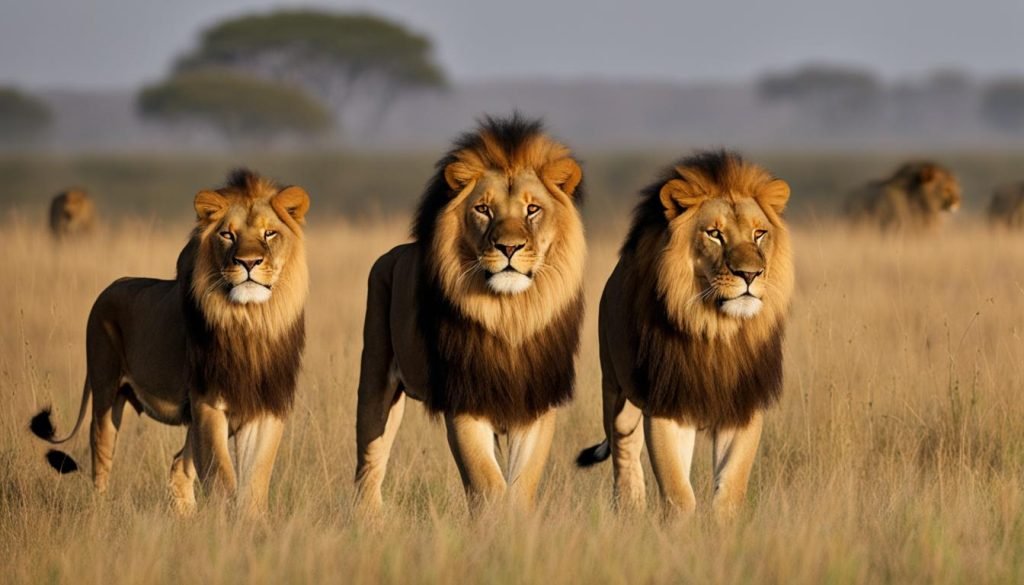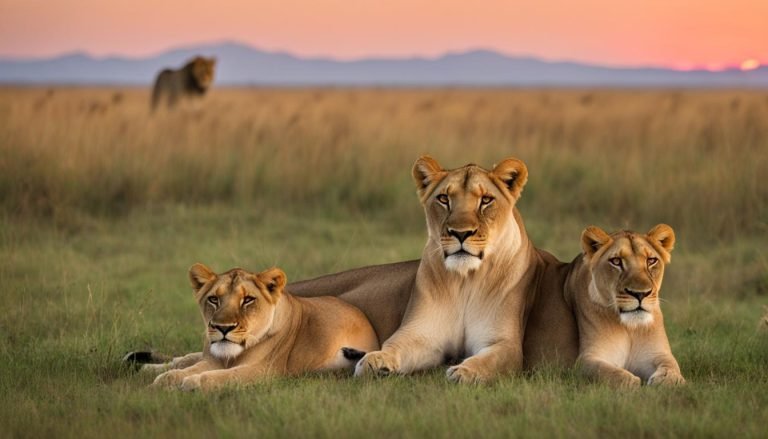How Much Do Lions Weigh? Lion’s Weight Revealed
Lions are one of the most fascinating animals on the planet. They are known for their majestic presence, powerful roar, and impressive size. The weight of lions is a topic that has intrigued many wildlife enthusiasts. Understanding their weight in relation to their size provides valuable insights into their physical capabilities, hunting behavior, and overall survival in the wild.
In this article, we will explore the average weight of lions in the wild, the factors that influence their weight, and the variations in weight among different lion subspecies. We will also examine the methods used to estimate lion weight and its significance in conservation efforts.
Key Takeaways
- Lion weight is important to understand in relation to their size and physical capabilities.
- The average weight of lions in the wild is influenced by factors such as diet, age, and geographic location.
- Male and female lions have different weight ranges due to reproductive and hunting responsibilities.
- Verifying information is crucial when discussing lion weights and avoiding dubious claims.
- Estimating lion weight is done through body condition scoring and advanced technology such as remote cameras and drones.
How Much Do Lions Weigh: Average Lion Weight in the Wild
Understanding the average weight of lions in the wild is crucial to gaining insights into the species’ physiology and behavior. According to research, the average weight range of wild adult male lions is between 330 to 550 pounds, while female lions weigh between 260 to 400 pounds.
The weight of wild lions can be influenced by various factors, including their diet, age, and geographic location. For instance, lions living in moist, wooded regions may have a higher weight than those living in dry, arid areas, where food sources are scarce.
In addition to these factors, the availability and abundance of prey play a major role in determining lion weight in the wild. The average weight of lions can vary significantly depending on the prey they hunt and consume, with larger prey resulting in a higher weight range for the lions that hunt them.
Average Lion Weight in Different Regions
| Region | Average Male Lion Weight (lbs) | Average Female Lion Weight (lbs) |
|---|---|---|
| Africa | 418- 495 | 280- 375 |
| India | 330- 570 | 250- 350 |
| Namibia | 418- 510 | 264- 352 |
The table above showcases the average male and female lion weight ranges across different regions. While genetics and other factors can cause variations, the data shows a general trend of higher average lion weights in African lions, followed by Indian and Namibian lions respectively.
It is worth noting that while the average lion weight in the wild may vary, it is essential to monitor the health and condition of individual lions, regardless of their weight. Integrating this knowledge into conservation efforts can help us better protect and sustain these iconic big cats.
Lion Weight Comparison Across Genders

Male and female lions show distinct differences in weight, with adult males typically being larger and heavier than females. Male lions have an average weight range of 330 to 550 pounds (150 to 250 kg), while females weigh between 265 to 400 pounds (120 to 180 kg).
The weight of lions is influenced by various factors, including age, genetics, and habitat conditions. However, the main reason for the difference in weight between genders is related to their roles in reproduction and hunting. Male lions are responsible for defending their pride and taking down larger prey, leading to their larger size and weight. On the other hand, female lions are typically responsible for hunting smaller prey and caring for cubs, which requires a lighter, more agile body.
| Lion Gender | Average Weight Range |
|---|---|
| Male Lion | 330 to 550 pounds (150 to 250 kg) |
| Female Lion | 265 to 400 pounds (120 to 180 kg) |
It is important to note that while male lions are generally larger and heavier than female lions, individual variations in weight can occur due to various factors. For example, a female lion may weigh more than a male lion due to an exceptional diet or favorable habitat conditions.
Understanding the weight and size differences between male and female lions can provide valuable insight into their behavior, population dynamics, and ecological role. This knowledge is crucial for conservation efforts aimed at protecting lion populations and their habitats.
Factors Affecting Lion Weight

While the average weight of a lion is around 190-280 kilograms, there is a considerable lion weight range that can span up to 420 kilograms. It’s essential to understand the various factors that can impact a lion’s weight range, ranging from biological to environmental. The following are the most crucial factors influencing a lion’s weight:
| Factors | Impact on Lion Weight |
|---|---|
| Age | As lions age, their weight typically decreases due to a decline in muscle mass. This impact is more notable in males than in females. |
| Genetics | Slight variations in genetics can impact a lion’s weight range. For instance, lions in different subspecies may have different weight averages due to their unique genetic makeup. |
| Health | The overall health of a lion can influence its weight range. For example, lions affected by diseases or parasites may experience weight loss and muscle atrophy. |
| Habitat conditions | The availability of prey in a lion’s habitat can impact its weight range. Lions with an abundance of prey may have a more substantial weight range than those with limited prey options. |
Understanding the factors that impact a lion’s weight is essential in ensuring their well-being and conservation. Monitoring weight changes can provide valuable insights into their health status, and population trends and guide conservation efforts.
Size and Weight Variations in Lion Subspecies

The weight range of lions can vary greatly between subspecies. The geographic location and available prey can significantly impact a lion’s weight, resulting in substantial variations among subspecies. For instance, the Asiatic lion, found in India, is generally smaller and lighter than its African counterparts.
African Lion Subspecies and Weight Range
The African lion has several subspecies, each with its distinct physical characteristics, including size and weight. The following table provides an overview of the weight range for three African lion subspecies:
| Lion Subspecies | Weight Range |
|---|---|
| Southwest African Lion | 260 to 420 pounds |
| East African Lion | 265 to 420 pounds |
| Barbary Lion | 330 to 550 pounds |
It’s essential to remember that the weight range given above serves only as a basic guideline. Actual weights may differ based on various factors like gender, diet, age, and habitat conditions.
The Barbary Lion subspecies typically weigh more than the others and has a greater mane that extends down to its elbows, making it easily recognizable. However, this subspecies has been extinct in the wild since the early 20th century.
A notable example of subspecies and weight variation is the lions of the Serengeti.
The Serengeti hosts several subspecies of lions, including the eastern and southern African sub-species. Lions in the Serengeti typically weigh between 250 and 420 pounds, with males being heavier than females. However, variation occurs between the different subspecies in the area, with lions near Tanzania’s Crater Highlands growing to be much larger.
The Heaviest Lion on Record

While lions typically weigh between 330 and 550 pounds, there have been record-breaking weights that surpass these numbers by a significant margin. The heaviest lion on record, for example, weighed an incredible 826 pounds. This lion was reportedly shot in 1936 in Kenya, although some sources have disputed the authenticity of this claim.
Similarly, another lion that was shot in the same region was said to weigh a staggering 990 pounds. Despite the lack of concrete evidence to support these reports, they remain a part of lion-weight folklore.
The majority of lions, however, fall within the typical weight range, with adult males weighing between 330 and 550 pounds, and adult females weighing between 240 and 400 pounds. Factors such as age, genetics, and habitat conditions can affect the weight of individual lions, and there can be variations in weight among different subspecies as well.
Top 5 Heaviest Lions on Record
| Lion | Weight (lbs) | Location | Date |
|---|---|---|---|
| X | 990 | Kenya | Unknown |
| Y | 826 | Kenya | 1936 |
| Z | 770 | South Africa | 1938 |
| A | 690 | South Africa | 1983 |
| B | 670 | Tanzania | 1963 |
The table above showcases some of the heaviest lions on record, based on verified reports. However, it is important to note that there are many reports out there that have not been verified and should be treated with caution. As with any aspect of lion weight, it is crucial to rely on credible sources and research when seeking accurate information.
Dubious Claims of Oversized Lion Weights
While lions are certainly one of the largest mammals in the animal kingdom, exaggerated reports of their weight are dubious in some cases. Claims of oversized lion weights have been made over the years, particularly in the context of hunting trophies or record-breaking specimens.
“There is a real danger in relying on anecdotal reports for assessing lion population trends,” says Dr. Craig Packer, director of the Lion Research Center at the University of Minnesota. “We need to be careful about drawing conclusions from data that is not based on a sound scientific approach.”
It is important to verify the accuracy of any claims about lion weight by cross-checking information with reliable sources. Furthermore, it is worth noting that lion weight can vary considerably due to factors such as age, diet, and habitat conditions. Therefore, while some lions may indeed weigh more than others, it is essential to approach any claims of oversized weight with a healthy dose of skepticism, and the acknowledgment that reliable scientific evidence is needed to support such claims.
Methods for Estimating Lion Weight
Researchers and conservationists use various methods to estimate the weight of lions. These methods rely on factors such as body condition, visual comparison, and advanced technology like remote cameras and drones.
The most common technique for estimating lion weight is body condition scoring. This method involves assessing the lion’s overall physical condition and assigning a score based on its body fat percentage and muscle mass. A lion’s weight can then be estimated based on this score.
The visual comparison is also used to estimate lion weight. In this method, observers compare the lion to other known-weight individuals, typically using photographs or videos. The observer also considers factors such as age, gender, and body condition when making the estimate.
Advanced technology like remote cameras and drones are increasingly being used to estimate lion weight. Remote cameras can capture images of lions from different angles, providing a better assessment of their body size and condition. Drones can also be used to capture images and video footage of lions, allowing for more accurate weight estimates.
To determine lion weight range across populations, conservationists conduct extensive research and analysis. They study the factors affecting lion weight, including genetics, diet, age, and habitat conditions. By combining these factors, researchers can estimate the typical weight range for a particular population of lions.
Comparison of Methods for Estimating Lion Weight
| Method | Accuracy | Equipment Needed |
|---|---|---|
| Body Condition Scoring | Good | None |
| Visual Comparison | Fair | Photographs or videos |
| Remote Cameras | Excellent | Camera traps |
| Drones | Excellent | Unmanned aerial vehicles |
Overall, the accuracy of these methods varies, with some being more reliable than others. However, by using a combination of techniques and considering various factors, researchers and conservationists can estimate lion weight with reasonable accuracy. Knowing how much lions weigh is essential for understanding their physical health, behavior, and conservation status.
Lion Weight and Conservation Efforts
Tracking and monitoring lion weight plays a crucial role in efforts to conserve and protect these magnificent animals. By gauging the weight of lions, researchers and conservationists can determine their overall health and well-being. Monitoring the changes in lion weight over time can provide essential insights into their diet, habitat, and population trends, allowing for informed conservation efforts.
In addition, understanding the weight of adult lions is crucial for ensuring that they are fit and strong enough to hunt and fend off predators. A healthy adult male lion can weigh up to 420 pounds, while adult females typically weigh up to 280 pounds.
Conservationists use a variety of methods to track lion weight, including body condition scoring, visual comparisons, and remote cameras. By understanding the weight and overall condition of a lion population, conservationists can make informed decisions about conservation management and habitat protection measures.
The well-being of lion populations depends on monitoring their weight and taking appropriate steps toward conservation efforts.
“Lions are an important part of our ecosystem and it’s our responsibility to monitor their weight and ensure their survival for future generations.”
The Importance of Lion Weight
Understanding a lion’s weight is vital in comprehending the physical condition and overall survival of these majestic animals in the wild. A lion’s weight plays a critical role in their hunting abilities and reproductive success, directly impacting their population growth and conservation status.
By monitoring lion weight, conservation efforts can track the health of individuals and populations, detect changes in diets and habitats, and identify potential threats such as disease outbreaks and poaching activities.
Moreover, estimating lion weight can provide insights into the age and gender of individuals, allowing researchers to determine population demographics and assess the success of breeding programs.
Overall, lion weight and size are key factors in understanding the biology, behavior, and conservation status of these apex predators. It is essential to continue researching and monitoring lion’s weight to ensure the survival and longevity of these iconic animals for generations to come.
More About Lions:
- Lion Defense Tactics: How Do Lions Protect Themselves?
- What Do Lions Need To Survive? Habitat, Diet & More
- Do Lions Eat Humans?
- Cannibalism in Lions: Do Lions Eat Other Lions?
- Do Lions Hibernate During Winter?
- What Do Lions Do During the Night?
- How Do Lions Communicate With Each Other?
- Where Do Lions Sleep?
- How Big Can Lions Get?
- How Fast Can Lions Run?
- Can Lions Swim? Lion’s Swimming Ability Examined
- How Long Do Lions Live? Wild vs Captivity
- How Do Lions Mate? – Lion Reproduction







